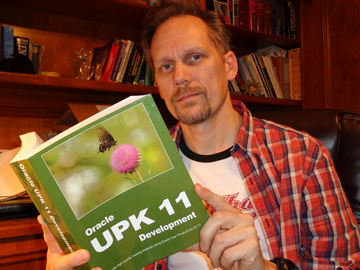Way back in 2009 I thought it would be fun to write a book. The result of this ill-thought-out endeavor was Oracle User Productivity Kit 3.5, a technical reference to an obscure piece of software that myself and apparently three other people used. Although it didn’t sell particularly well (around 1,000 copies), it was a fun little project that kept me busy for a couple of months, and gave me something new to put on my resume.
Once I’d finished it I had absolutely no intention of writing another book (or certainly not another reference work – I’m still working on The Great (Anglo-)American novel), but when Oracle released a new version if the software (version 11 – I just cannot understand their numbering system: 9.1 then 3.5, then 11.1..), I started getting asked for an updated edition. After several months of procrastination, I finally relented, and contacted the publishers of the first book. Unsurprisingly, they were even less enthusiastic than I was, and after humoring me for a couple of months by referring me to a different person each time I contacted them, they eventually just stopped responding to my emails. By this time I had already written most of the book (and was still getting requests for an update) so made another ill-thought-out decision and decided to just publish it myself.
Surprisingly, this was much easier than I initially thought it would be. There are quite a few websites that facilitate self-publishing, but in the end I opted for CreateSpace, because they are closely-affiliated with Amazon (I think it’s actually a subsidiary) and most copies of my last book were sold via Amazon. Setting up a book is very easy (and thankfully involves zero direct interaction with other people, which is another key requirement for me) – you just fill in a bunch of fields, apply for an ISBN, and pick a sales price.
Uploading a book is also pretty painless. CreateSpace accept PDF files, which meant that I had absolute control over the final format. Sort of. The main problem I had was that Microsoft Word decided that every numbered list in the entire book was a part of the same single list, and numbered them accordingly (from 1 to about 600). I could “restart at 1” on every list but then every time I closed the document and reopened it, Word would renumber all of the lists all over again it again. Handy! Then, Adobe Acrobat decided it would just throw away half of the images in the book, It still left space for them, but didn’t actually include the image;. Again, handy!. Luckily, Word itself comes with its own PDF writer which, although it doesn’t have the granularity of control (especially over downsampling and font embedding) that I would have liked, at least managed to generate a complete PDF that I could get the book uploaded to CreateSpace.
Creating the cover was also easy, and again I was happy to have complete control over this, using a cover image by my buddy and talented photographer Gerry McGlamery, and some blurb of my own. Despite CreateSpace’s templates suggesting otherwise, I resisted the temptation to add a photo of the author to the back cover (it’s not a horror story…), and in a fit of modesty I even omitted my name from the front cover (because a book on UPK will just sell itself, right?).
CreateSpace includes a an on-line proofing/verification tool that handily told me my images were at too low a resolution (but as they are screenshots I wasn’t overly-worried by this) and that some fonts hadn’t been embedded (thanks to Word’s limited PDF control), but after a quick review, I was satisfied that it all looked good, and submitted the book for print. Actually, CreateSpace insist that a ‘real person’ looks at the files just to make sure that they are printable, but they also promise a turnaround of 24 hours so I suspect it is actually a machine. Or some offshore ‘editor’ in Mumbai, whcih doesn’t exactly fill me with confidence – especially as my other job is proofreading very poorly-written books for a Mumbai-based publisher…). No matter, they lived up to their 24 hour turnaround, and a day after I uploaded the files, the book (Oracle UPK 11 Development)was available for purchase via Amazon, CreateSpace, and wherever else they sell it through (I paid an extra $24.95 for their “extended distribution network” although they don’t exactly say what this is – probably the remainders bin at the Dollar Bookstore…).
 The book is officially “print on demand”, so I decided to put this to the test. As soon as I had loaded it, I ordered a copy from Amazon, and asked for next day delivery. And sure enough, the next day, a pristine, 716-page, 3.3lb, professionally-bound book thudded onto my doormat courtesy of UPS! Pretty impressive! Of course, I haven’t read it – after slaving over it for the best part of six months, the last thing I wanted to do was to open it up and risk seeing some typo I’d missed, or formatting I didn’t like. But it sure looks good on my bookshelf (next to my last book)…
The book is officially “print on demand”, so I decided to put this to the test. As soon as I had loaded it, I ordered a copy from Amazon, and asked for next day delivery. And sure enough, the next day, a pristine, 716-page, 3.3lb, professionally-bound book thudded onto my doormat courtesy of UPS! Pretty impressive! Of course, I haven’t read it – after slaving over it for the best part of six months, the last thing I wanted to do was to open it up and risk seeing some typo I’d missed, or formatting I didn’t like. But it sure looks good on my bookshelf (next to my last book)…
Another advantage of using CreateSpace is that they make it very easy to create a Kindle version of a book. You just click a button and it will take the PDF you uploaded for the print version, and magic this into a Kindle-format e-book. Unfortunately, although this allowed me to make the Kindle version available at the same time as the print version, I soon discovered that Kindle doesn’t play well with PDFs – in fact, it loses all of the tables, and generally screws up any nice formatting you’ve tried to use. Maybe it works well for standard chapter books, but for a technical reference that someone’s spent hours tweaking to look ‘just right’, it’s awful. Luckily the forums were kind enough to point out that Word documents can be much more satisfactorily ported to Kindle, so I re-uploaded my book, this time in the original Word format, and that came out looking pretty good. Not ideal (I could have tweaked the HTML if I could get Dreamweaver to accept a 20-Meg file…), but acceptable.
Anyway, overall, self-publishing has been pretty painless. It’s given me a book that looks no less professional than my first book (which was published by a ‘real’ publisher). In fact, it’s given me a lot more control over the finished product, and has also doubled the (meager) amount I make off each book, which is a good result. The only downside is that it shows that anyone can publish a book, which significantly diminishes the cachet attached to publishing a book. If any old idiot can get their book published, what’s to say that I’m any better than the next idiot? Well, sales, I guess. These have been ‘steady’ so far, but I’m not exactly going to retire on the royalties. Maybe it would have sold better if I’d called it Fifty Shades of UPK. Never mind; it was another ‘fun’ experience. I’m even thinking of writing another one (although I’d use Adobe Indesign if I did it again, not Word). All I need is another 6 months with no distractions, and something else I know about besides UPK. You know, I’ve always thought the world could use another Frank Zappa biography…

Leave a Reply